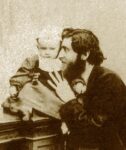
Giorgio Sommer
German, 1834-1914 (active Italy)
Tempio di Nettuno, Pesto (Temple of Neptune, Paestum), 1860 ca.
albumen silver print
8 1/8 x 10 1/4 in.
SBMA, Museum purchase with funds provided by FOPA
1997.3.28

Giorgio Sommer with his son Edmondo in 1864, self-portrait, detail
COMMENTS
Giorgio Sommer (1834-1914) was born in Frankfurt am Main (in modern day Germany), and became one of Europe’s most important and prolific photographers of the 19th century. Active from 1857 to 1888, he produced thousands of images of archeological ruins, landscapes, art objects and portraits.
After studying business in Frankfurt, Sommer opened his first photography studio, during which time he worked in Switzerland, where he made relief images of mountains for the Swiss government. In 1856 moved his business to Naples and later (1866) formed a partnership with fellow German photographer Edmund Behles (also known as Edmondo Behles) who owned a studio in Rome. Operating from their respective Naples and Rome studios, Sommer and Behles became one of the largest and most prolific photography concerns in Italy.
Sommer’s catalog included images from the Vatican Museum, the National Archeological Museum at Naples, the Roman ruins at Pompeii, as well as street and architectural scenes of Naples, Florence, Rome, Capri and Sicily. Most notably, Sommer published his comprehensive album "Dintorni di Napoli" which contained over one hundred images of everyday scenes in Naples. In April 1872, he documented a very large eruption of Mount Vesuvius in a series of stunning photographs.
Sommer and Behles exhibited extensively and earned numerous honors and prizes for their work (London 1862, Paris 1867, Vienna 1873, Nuremberg 1885). At one time, Sommer was appointed official photographer to King Victor Emmanuel II of Italy.
Sommer was involved in every aspect of the photography business. He published his own images that he sold in his studios and to customers across Europe. In later years, he photographed custom images for book illustrations, as well as printing his own albums and postcards. Sommer worked in all the popular formats of his day: carte de visite, stereoview, and large albumen prints (approximately 8x10) which were sold individually and in bound albums.
The partnership with Behles ended in 1874, after which each photographer continued his own business. In Naples, Sommer opened a total of four additional studios: at No. 4 and No. 8 Monte di Dio, No. 5 Magazzino S. Caterina, and a last at Piazza della Vittoria.
Sommer died in Naples in 1914.
https://en-academic.com/dic.nsf/enwiki/4122798
SBMA CURATORIAL LABELS
Born in Frankfurt, Germany, Giorgio Sommer established a photographic career in northern Europe before moving to Naples in 1856. With a business partner and on his own, Sommer created a huge number of photographs of southern Italy, including Pompeii, the Amalfi Coast and Sicily, that unmistakably combined the documentary with the aesthetic. One such photograph is the view of the rocks of the Cyclops in southeastern Sicily. Legend says that the blinded one-eyed monster, Polyphemus the Cyclops, threw these huge rocks at Odysseus and his men as they craftily fled imprisonment from his cave. Such a fantastic melding of material fact, ancient myth, and real place can be found throughout the landscapes of the Greco-Roman world.
- Greco-Roman, 2022
